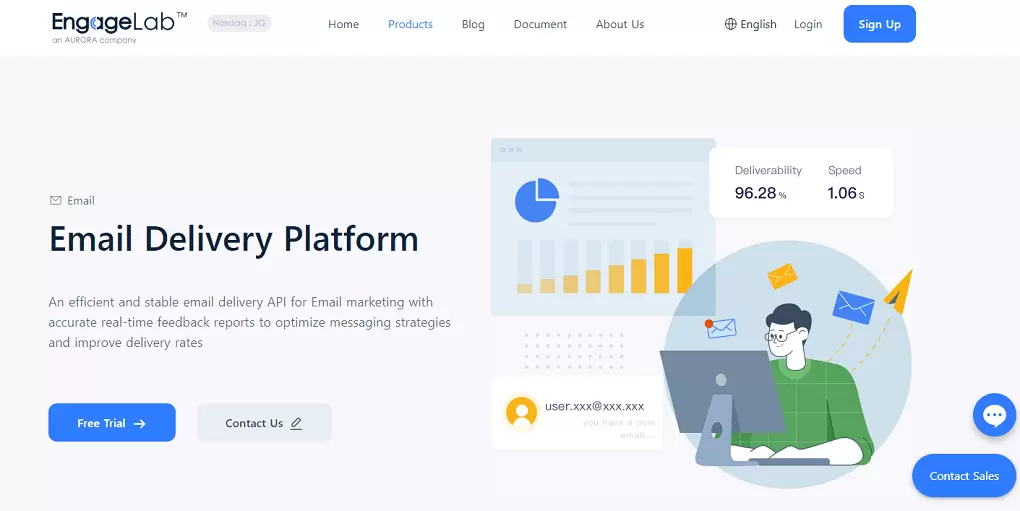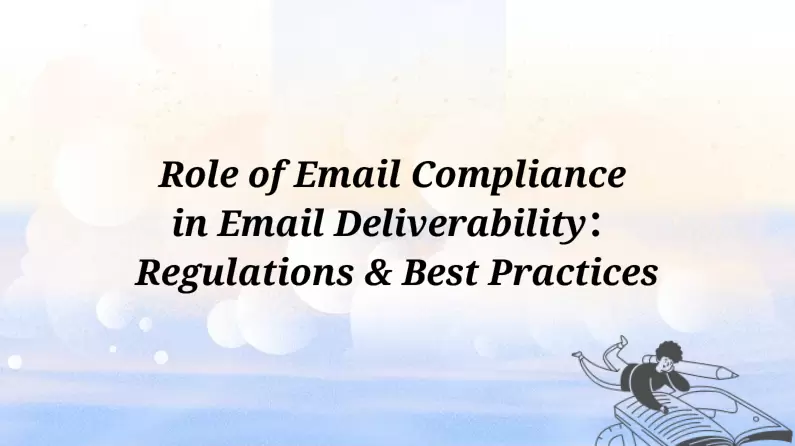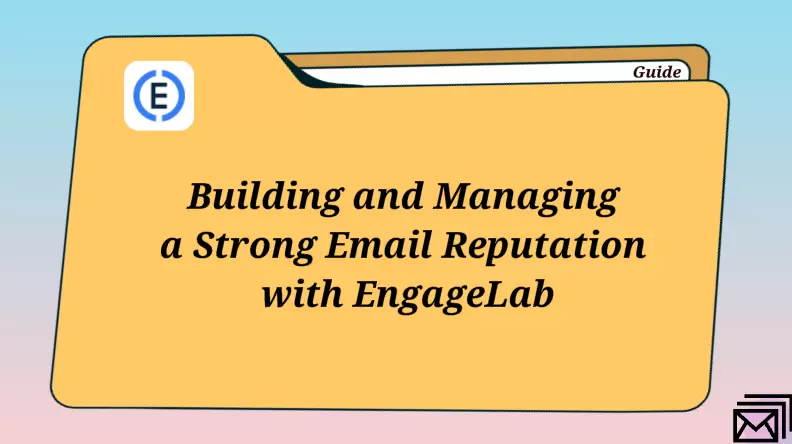The issue of emails landing in the 'Spam' folder is a common phenomenon that many individuals and businesses face. It is more common in organizations that send bulk emails without using a reliable email-sending service.
If you are facing the issue of your emails getting spammed and you want to learn how to prevent emails from going to spam, we can help you out. You can take certain steps to stop emails from going to spam.
But before we thoroughly analyze these techniques, it is important to know why emails get spammed in the first place.
Why do Emails Get Spammed?
An email spam is a folder where all the unsolicited emails are present. Most of these emails are bulk from the sender and are typically meant for marketing purposes.

Following are the key reasons why emails get spammed:
- Lack of Authentication: A properly verified and authenticated email is important to send emails straight into inboxes instead of spam folders.
- Low IP Reputation: Emails from suspicious IPs or having a negative reputation are likely to end up in spam.
- Low Domain Reputation: Having a good domain reputation is also important to ensure email deliverability, especially in bulk.
- Poor Email Design: Poor or spammy content and the overall design of the email can negatively impact its deliverability.
- Negative Engagements: If your emails are used to receiving negative engagement, meaning getting reported as spam, all of your emails can go to spam.
- Technical Issues: Technical problems, such as broken HTML or issues in plain text versions, can make the emails unreadable and send them to spam.
Possible Consequences of Spammed Emails
Spammed emails hurt both the sender and the recipient as it disrupts the communication process. Following are some of the common consequences of spammed emails, especially in the context of business communication:
- Reduce productivity: Spammed emails significantly reduce the efficiency and productivity of business communication. Being bombarded with irrelevant emails can cause important emails to get lost.
- Greater security risk: Email spams are also known to be used for spyware and phishing attacks. Hence, they can pose extensive security risks and compromise an organization’s sensitive data.
- Miss the Email Objectives: Emails, especially marketing emails, are often sent in bulk to an extensive email list. These emails have a higher chance of getting spammed, which means the emails fulfill their marketing goals.
- Lower Customer Engagement: If your emails are not reaching the target audience and missing their objectives, your business will suffer from lower customer engagement and satisfaction.
- Lower Brand Reputation: When you are trying to establish a reliable and reputable brand, you must ensure high email deliverability. If the emails of a brand, company, or online software are getting spammed, it will cause significant damage to the brand's reputation.
- Increase Cost: Whether your emails are being sent to the spam folder or you are dealing with spammed emails, it will waste your resources, divert your attention from core business activities, and increase operational costs.
Overall, spammed emails can harm your brand and prevent you from reaching the target audience. So, you must be familiar with some effective strategies to stop your email from going to spam.
How to Prevent Emails from Going to Spam?
Now, let’s come to the crux of the topic: how to prevent emails from going to spam. Well, 10 tried-and-tested tips can ensure your emails are reaching the target audience and not ending up in your recipient's spam folder.
Tip 1: Get Relevant Permissions
To maximize the effectiveness of your email marketing campaigns and ensure email deliverability, you have to make sure that you have permission from the sender to send them the emails.
Without the relevant permissions, there is a high chance that your emails can get flagged as spam or even completely blocked. Getting these permissions can come in the form of building a large email list by encouraging website visitors to sign up for a newsletter or providing their email to download a digital product, such as an e-book.

Tip 2: Write Suitable Subject Lines
Email subject lines play an important role in ensuring their deliverability and encouraging the recipients to open the emails. You should focus on using customer-friendly language in all your marketing emails as per your branding.
Moreover, make sure that the language you are using is simple and doesn’t sound robotic, as it can get flagged as spam.
Overall, your aim should be to write subject lines that attract your customers and aim to fulfill their needs instead of putting too much emphasis on advertising material like promotional deals and discounts.

Tip 3: Personalize Your Emails
Sending personalized emails is an effective strategy to prevent emails from going into spam and also get more of the recipients to open your email. Personalization shows that you are paying attention to your audience base and writing the emails specifically for them. It is also useful in standing out from other companies, individuals, and brands that send non-personalized emails.
The most important thing is that personalization does not mean you have to write every name yourself. Instead, you can use a powerful customer engagement platform like EngageLab to send personalized and engaging emails to your email list.

Tip 4: Provide an Option to Unsubscribe
At first, you might assume that providing an option to unsubscribe from your emails can hurt your marketing goals, but it is critical to prevent emails from going into the dreaded spam folder. Having an unsubscription option is a way of giving respect to the recipients and also complying with the rules and best practices of email marketing.
The way you provide this option is completely dependent on your preferences. Generally, most brands add the unsubscription option at the very end of an email in the footer.
Tip 5: Email Domain Authentication
Gone are the days when businesses could use temporary emails or multiple emails to send bulk marketing messages. Email service providers nowadays have strong security and filtering protocols to identify fake email addresses and send emails from them into the spam folder.
Therefore, it is important to use properly verified and authentic email addresses. In this way, you will be able to make sure that your IP and DNS addresses are not flagged by the email service providers.

Tip 6: Include Relevant Content
Provide valuable information to the recipients by including engaging and relevant content in your emails. It also helps you avoid the spam folder as emails having suitable subject lines and content also tend to have high deliverability.
Some important things to consider while crafting email content are making sure you are including any new, urgent, or relevant information. The exact purpose of your email is dependent on your brand, so you might have to go through a trial-and-error phase to hit the right mark.
Tip 7: Keep Track of Your Email Engagement Metrics
Keeping track of your email metrics and overall performance is another way of making sure they are reaching the target audience. These metrics include email open rates, any spam complaints, delivery rates, and open-through rates.
Even if you are noticing a negative trend in these metrics, you should not get worried, as you can always turn it around by tweaking your email marketing strategies.

Tip 8: Clean Your Email List Regularly
If your recipients are not responding to your emails or, worse, not even opening them, then there is no use in keeping them on your email list. Therefore, it is important to regularly clean and update your email list after you thoroughly analyze the engagement metrics.
You can consider sending a re-activation email before removing someone from the list and asking them to decide whether they want to keep receiving the emails. Moreover, other than your email, you should ensure that there are only legitimate emails in your list.

Tip 9: Use Spam Checkers
Numerous spam-checking online tools allow you to determine the chances of a particular email being successfully delivered or being sent to the spam folder. While none of these tools have 100% accuracy, they are still a reliable way to make an educated estimate about the success of your email.
Tip 10: Use a Reliable Email Engagement Platform
The last and most important thing you can do to prevent your emails from going into spam is to choose a reliable and efficient email engagement platform like EngageLab. An authentic platform will make sure that your emails have high and quick deliverability. The secure email-sending protocols and integration options of EngageLab ensure you can send emails to a wide audience.
Why Choose EngageLab?
EngageLab is an all-in-one email platform. It allows you to manage an entire email marketing campaign from scratch. Whether it is crafting an engaging email template or analyzing the progress of your emails, you can perform all these functions within EngageLab.

Some of the key advantages of EngageLab are:
- High email delivery rates across the world by following best email practices and compliance rules to prevent them from going to spam.
- Safe and secure servers to protect the content of your emails.
- User-friendly APIs and configuration options to help you set up a successful email marketing campaign.
- A 24/7 customer support is available to help you configure the emails and answer any questions you might have about the platform.
- A wide range of templates and customization options to craft engaging emails.
You can start using EngageLab for free today and use the tool yourself to write and send emails successfully without the fear of them being sent to the spam folder.
Get Started For FreeConclusion
The bottom line is that any type of email being sent to the spam folder can adversely impact your communication. Both individuals and businesses need to follow the tips discussed throughout this article to stop emails from going to the spam folder.
Writing crisp and clear subject lines, engaging and relevant content, using verified email addresses, and a reliable platform like EngageLab will ultimately help you deliver the emails to its target recipients in the inboxes.
FAQs
Why do Emails Suddenly Go to Spam?
Emails can start going to spam for many reasons, such as if they are being sent in bulk or an email has inappropriate and spammy content. Learn more about how to choose the best provider for bulk email services-Mastering Bulk Email Services: A Definitive Guide to Driving Growth.
What does Spam Email Mean?
Spam emails typically refer to unsolicited bulk emails. It means the recipient has not permitted for email to be sent. A large number of marketing emails sent by a brand are at a higher risk of landing in the spam folder.
How to Avoid Email Going to Spam?
Get permission from the people in your email list, write relevant subject lines and content, verify your emails, personalize the content, and use a powerful email engagement platform like EngageLab to avoid emails going to spam.








